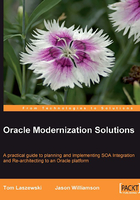
What We Won't Cover
Before we begin our path to modernization, let's take some time to talk about the things that we will not cover in this book. The main focus of this book is a practical application of how to modernize a legacy application using two specific techniques. We won't cover topics such as marketplace, methodologies, and estimation techniques.
Methodology and Estimation
Countless books have been written on application development methodology. Every system integrator/programming shop within a large company or technology group has a general development methodology, be it waterfall, agile, or eXtreme programming. The techniques in this book can fit any given protocol.
Estimation is a bit different and varies from system to system and with the choice of the modernization option. It can depend upon factors such as target language, tools, and the level of automation you are employing. If someone tries to sell you a solution based on the line of code or function point counts and complexity, you can pretty much throw that out of the window. Function point analysis is a great tool for understanding the complexity of the source code and can drive estimation, but there is certainly no general formula for how long a modernization will take, or how much it will cost. Another book can be written on this subject.
The Modernization Marketplace and Why Modernize
If you are reading this book, then we will assume that application modernization is a necessity for you. You are looking at "how to modernize" rather than "why modernize". Further, much market research has been done on this subject. Countless presentations, white papers, and events are actively being conducted on this subject.
The largest and best of breed systems integrators of the world have practices built solely around the modernization market. There are several reasons that drive a legacy modernization project. High costs, lack of agility, an aging technology workforce are just some of the reasons for modernization. Sometimes the motivation to modernize is driven from the business, at other times it is pure technology play. The reasons are many, and the final decision to embark on this effort depends on each organization. Again, much material is being developed on this subject and is not the topic of this book.
The Oracle Modernization Alliance (OMA) is an effort by Oracle to bring together the best of breed partners and products to enable modernization to open systems. This is truly an emerging field both for companies considering modernization, and for the companies working to provide those technologies. The OMA is a resource to help customers identify the best path to modernization. The following is a table of some key resources that you can have access to from Oracle around modernization. In addition, we will list some key alliances that Oracle has in the modernization space. Here, you will find abundant market research, white papers, and links to key contacts for getting engaged on a modernization initiative.
Oracle Modernization Alliance resources are as follows:
- Oracle Modernization Alliance (http://www.oracle.com/goto/oma)
- Oracle Modernization Blog (http://blogs.oracle.com/jblog)
- Application Modernization Initiative (AMI) Oracle/HP/Intel (http://www.hp.com/go/ami)
- Oracle Migration Technology Center (http://www.oracle.com/technology/tech/migration)
- Oracle Migration Knowledgebase (http://www.oracle.com/technology/tech/migration/kb)
Oracle works with many global systems integrators who focus on legacy modernization. The following is a list of the current system integrators that are apart of the Oracle Modernization Alliance.

Deep Dive on Approaches
There are five primary options for modernization, and all are worthy of deep exploration. In the next section, we will review each of these options at a high level. However, this book is a deep technical dive on two approaches for Legacy Modernization, namely SOA enablement and re-architecture. These two options are selected for two reasons. First, it gives a modernization option for staying on the mainframe (SOA enablement) and moving off the mainframe (re-architecture). Second, many organizations around the world are engaged on one of these two paths, or both in many cases. Although either modernization option can be chosen independently, together they provide a smooth and measured path to a modern environment without the risk of a big bang approach. We also cover a rehosting-based approach to modernization, which minimizes the upfront risk and supports SOA enablement and selective re-architecture during or following the automated platform migration. We will cover more of this later.